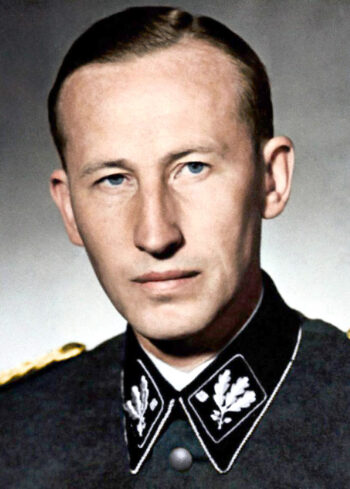Heydrich, Reinhardt

Reinhardt Heydrich (7 March 1904 – 4 June 1942), SS Obergruppenführer, has been the head of the National-Socialist Party’s Security Services (Sicherheitsdienst) since its inception in 1931. As Heinrich Himmler’s deputy, he was head of the Security Police and the Security Services, which were merged in 1939 into Germany’s equivalent of the Department of Homeland Security, the Reich Security Main Office (Reichssicherheitshauptamt, RSHA). Heydrich headed the RSHA until he died on 4 June 1942 after an assassination orchestrated by the British.
Prior to the war against Poland, Heydrich was tasked with forming the so-called Einsatzgruppen of the Security Police and the SD, whose task was to pacify the occupied Polish territories. These Einsatzgruppen were then also deployed on the temporarily German-occupied Soviet territories.
The orthodox narrative has it that Heydrich’s role in organizing and carrying out the so-called Holocaust was crucial in many regards. Here are the documented decisions that Heydrich made or implemented with regard to the “Jewish Question”:
- On 24 January 1939, Heydrich was appointed by Göring as head of the Reich Center for Jewish Emigration in Berlin (Reichszentrale für jüdische Auswanderung).
- On 15 July 1939, Heydrich ordered Eichmann to set up a Central Office for Jewish Emigration in Prague (Zentralstelle für jüdische Auswanderung).
- On 24 June 1940, Heydrich wrote to Joachim von Ribbentrop, German Minister of Foreign Affairs, saying that the Jewish problem could no longer be solved “by emigration” but required “a territorial final solution;”
- On 20 May 1941, Heydrich prohibited the emigration of Jews from France and Belgium in an effort to render the emigration of “Jews from the Reich territory” easier.
- On 31 July 1941, Heydrich was entrusted by Hermann Göring with the task of making preparations “for a comprehensive solution of the Jewish question within the German sphere of influence in Europe” in “addition” to the tasks Göring had given him on 14 January 1939, meaning to resolve “the Jewish question by means of emigration or evacuation.”
- On 18 September 1941, Himmler ordered Heydrich to implement the Judenwanderung (Jewish migration) via Łodź.
- On 10 October 1941, Heydrich declared in Prague that plans were drawn up to deport 50,000 Jews from the Protectorate to Minsk and Riga between 15 October and 15 November, where they were to be housed “in the camps for communist detainees in the operational territory.”
- On 20 January 1942, Heydrich headed the Wannsee Conference on the policy of Jewish emigration. He reported that, as a result of the Third Reich’s policy of emigration, some 537,000 Jews had emigrated from the Reich territory by 31 October 1941. He also stated that Himmler had “forbidden any further emigration of Jews in view of the dangers posed by emigration in wartime and the looming possibilities in the East.” He added that, “as a further possible solution and with the appropriate prior authorization by the Führer, emigration has now been replaced by evacuation to the East.” This conference resulted in a slew of correspondence between various government agencies, with the main contentious subject being a possible mass sterilization of certain groups of Jews. However, no such mass-sterilization program was ever initiated, let alone implemented. None of these documents hints at any kind of extermination.
Heydrich was therefore indeed the chief planner of the final solution in Europe, but as all these and other documents show, this term actually designated the evacuation of the Jews from Europe to the temporarily German-occupied Soviet territories.
Heydrich’s first name was probably the namesake for “Aktion Reinhardt” – the vast program of expropriation and deportation of Jews for resettlement or forced-labor deployment. See the entry on Aktion Reinhardt for details.
(For more details on Heydrich’s role, see Graf/Kues/Mattogno 2020, pp. 201-225, 255f.)

You need to be a registered user, logged into your account, and your comment must comply with our Acceptable Use Policy, for your comment to get published. (Click here to log in or register.)